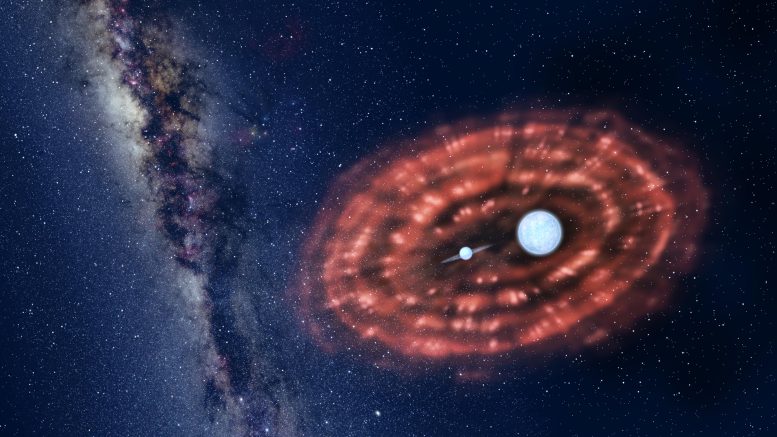
Artist’s impression of the common-envelope evolution in a binary system J 1920. Credit: Jingchuan Yu
Chinese and Australian Astronomers Find Direct Evidence for Binary Common Envelope Evolution
A team of astronomers has jointly discovered a binary system ejecting a common envelope at a speed of about 200 kilometers per second (450,000 miles per hour). The researchers were led by Prof. Zhanwen Han from the Yunnan Observatories (YAO) of the Chinese Academy of Sciences and Prof. Chris Wolf from the Australian National University.
This is the first time astronomers have observed direct evidence of common envelope evolution, which is a key process of binary star evolution. This significant discovery provides a way to accurately characterize the common envelope evolution of binary stars through observation.
The study was published on July 7, 2022, in Monthly Notices of the Royal Astronomical Society.
Stars make up the majority of the luminous objects in the universe. It is believed that more than half of all stars are part of binary systems. Two stars in a binary system orbit around each other due to their gravitational attraction.
The fate of stellar objects is significantly influenced by the evolution of binary systems. It has often been cited as the explanation for most mysteries in astronomy and astrophysics such as the formation of unusual stellar objects including Type Ia supernovae, double black holes, and double neutron stars, etc.
Common envelope evolution is one of the key processes of binary evolution. In this process, the donor star of a binary system expands dramatically due to the mass loss, thus leading to the two stars spiraling towards each other and the formation of a common envelope. This process determines the subsequent evolution of the binary system. A binary system with a shorter orbital period would be expected to form if the common envelope is ejected successfully. Otherwise, the two stars within the common envelope would merge into a single object.
Common envelopes were first postulated by B. Paczynski in 1976. However, a common envelope had never been seen before now. As a consequence, scientists were quite unclear about what exactly happens during the common envelope phase of binary star evolution.
Based on the observations from the 2.3-meter wide-field telescope at Australian National University and the Kepler Space Telescope, Chinese and Australian scientists have jointly found a binary system consisting of a hot subdwarf and a white dwarf, named J 1920. In this binary system, the two stars orbit around each other with an orbital period of about 3.5 hours, and are getting closer and closer.
In addition, scientists have seen that this binary system is surrounded by an expanding shell moving at a speed of about 200 kilometers per second (450,000 miles per hour). This expanding shell is further confirmed to be a common envelope that was ejected from the binary system about 10,000 years ago. Continuous orbital contraction observed in the J 1920 binary system indicates that friction caused by the orbital motion of the two stars in the envelope can severely dissipate orbital angular momentum. This is a new mechanism for angular momentum loss in addition to the mechanisms of magnetic braking and gravitational radiation.
The significance of this important discovery is that it turns a theoretical idea into reality. Scientists have not only seen the first evidence of common envelope evolution, but have also been able to accurately characterize the common envelope evolution of binary stars through observation.
Reference: “A Roche Lobe-filling hot Subdwarf and White Dwarf Binary: Possible detection of an ejected common envelope?” by Jiangdan Li, Christopher A Onken, Christian Wolf, Péter Németh, Mike Bessell, Zhenwei Li, Xiaobin Zhang, Jiao Li, Luqian Wang, Lifang Li, Yangping Luo, Hailiang Chen, Kaifan Ji, Xuefei Chen and Zhanwen Han, 7 July 2022, Monthly Notices of the Royal Astronomical Society.
DOI: 10.1093/mnras/stac1768










Quote: It is believed that more than half of all stars are part of binary systems. Unquote: If a binary system is 2 stars, then that implies that more than all stars are part of a binary system. Just saying….
The article did not state the distance to the binary system